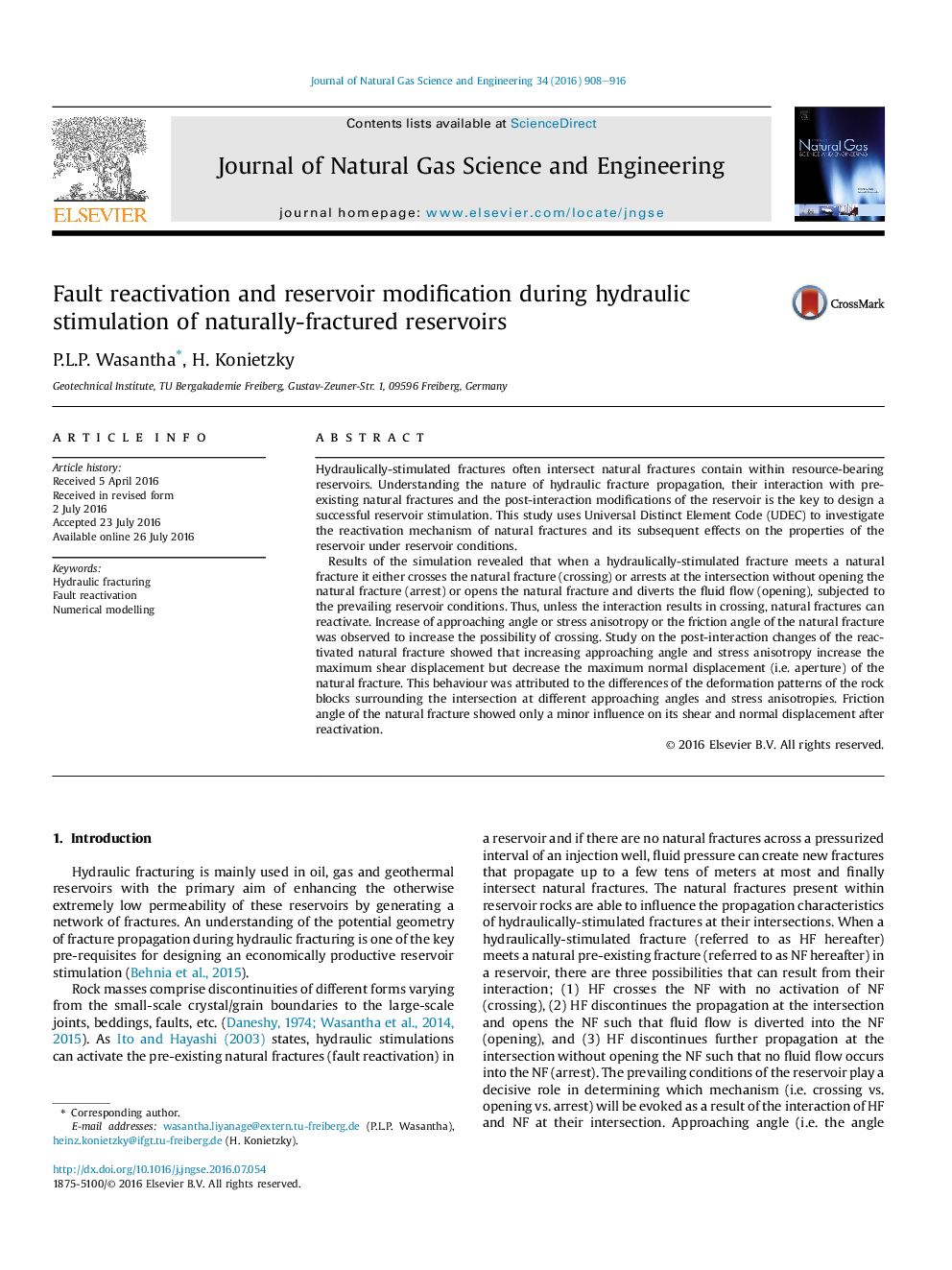| کد مقاله | کد نشریه | سال انتشار | مقاله انگلیسی | نسخه تمام متن |
|---|---|---|---|---|
| 8128775 | 1523007 | 2016 | 9 صفحه PDF | دانلود رایگان |
عنوان انگلیسی مقاله ISI
Fault reactivation and reservoir modification during hydraulic stimulation of naturally-fractured reservoirs
ترجمه فارسی عنوان
واکنش گسیختگی و تغییر مخزن در هنگام تحریک هیدرولیکی مخازن طبیعی شکسته
دانلود مقاله + سفارش ترجمه
دانلود مقاله ISI انگلیسی
رایگان برای ایرانیان
کلمات کلیدی
شکستگی هیدرولیکی، دوباره فعال شدن گسل، مدل سازی عددی،
ترجمه چکیده
نتایج شبیه سازی نشان داد که هنگامی که یک شکست ناشی از هیدرولیک با شکستگی طبیعی مواجه می شود، شکستگی طبیعی (عبور) یا دستگیری در تقاطع بدون باز کردن شکست طبیعی (بازداشت) یا شکستن طبیعی باز می شود و جریان سیال (باز کردن) )، تحت شرایط مخزن غالب قرار گرفته است. بدین ترتیب، مگر اینکه اثر متقابل در گذر از بین برود، شکستگی طبیعی می تواند دوباره فعال شود. افزایش زاویه نزدیک شدن یا انحصارطلبی استرس یا زاویه اصطکاک شکستگی طبیعی به منظور افزایش امکان عبور از آن مشاهده شد. بررسی تغییرات پس از تعامل شکستگی طبیعی فعال شده نشان داد که افزایش زاویه نزدیک شدن و انحصاری تنش باعث افزایش حداکثر جابجایی برشی می شود اما حداکثر جابجایی طبیعی (یعنی دیافراگم) شکست طبیعی طبیعی را کاهش می دهد. این رفتار به تفاوت الگوهای الگوهای تغییر شکل بلوک های سنگی در اطراف تقاطع در زوایای نزدیک شدن و انحصارطلبی استرس مربوط می شود. زاویه اصطکاک شکستگی طبیعی تنها تاثیر جزئی بر روی برش و جابجایی طبیعی پس از واکنش را نشان می دهد.
موضوعات مرتبط
مهندسی و علوم پایه
علوم زمین و سیارات
علوم زمین و سیاره ای (عمومی)
چکیده انگلیسی
Results of the simulation revealed that when a hydraulically-stimulated fracture meets a natural fracture it either crosses the natural fracture (crossing) or arrests at the intersection without opening the natural fracture (arrest) or opens the natural fracture and diverts the fluid flow (opening), subjected to the prevailing reservoir conditions. Thus, unless the interaction results in crossing, natural fractures can reactivate. Increase of approaching angle or stress anisotropy or the friction angle of the natural fracture was observed to increase the possibility of crossing. Study on the post-interaction changes of the reactivated natural fracture showed that increasing approaching angle and stress anisotropy increase the maximum shear displacement but decrease the maximum normal displacement (i.e. aperture) of the natural fracture. This behaviour was attributed to the differences of the deformation patterns of the rock blocks surrounding the intersection at different approaching angles and stress anisotropies. Friction angle of the natural fracture showed only a minor influence on its shear and normal displacement after reactivation.
ناشر
Database: Elsevier - ScienceDirect (ساینس دایرکت)
Journal: Journal of Natural Gas Science and Engineering - Volume 34, August 2016, Pages 908-916
Journal: Journal of Natural Gas Science and Engineering - Volume 34, August 2016, Pages 908-916
نویسندگان
P.L.P. Wasantha, H. Konietzky,
